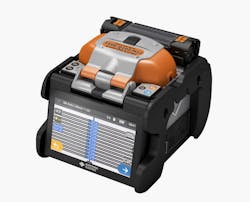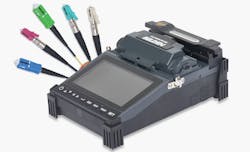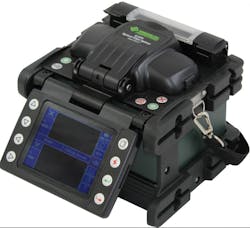Advances abound for fusion splicers
By Patrick McLaughlin
If you haven’t seen the movie The Hummingbird Project, it’s worth checking out. The protagonists attempt to construct an as-straight-as-possible fiber-optic line between Kansas and New Jersey for the purposes of high-frequency trading. In addition to the novelty that the story line relates directly to the work you regularly perform, the movie includes real-life props that will look familiar. Belden served as a technical consultant to the movie, and worked with the production team to ensure the fiber-optic installation scenes were as realistic as possible.
In a blog post from early 2019 before the movie’s release, Belden product manager Benoit Chevarie recalls, “After reviewing the script, we met with the team in person to discuss specific scenes. To create realistic settings involving the installation of a straight fiber-optic tunnel, the correct products, tools and accessories would be needed … Belden created a list of cables and connectivity solutions to pull off this feat, including fiber spools, connectors, patch cords, splicers and cleavers.”Even if you didn’t see the movie, you may have seen a Belden fusion splicer about one minute into the trailer that made the rounds prior to the movie’s March 2019 release.
Fortunately for all of us, tools like fusion splicers are used for making connections that enhance our society rather than simply to serve its underbelly, like high-frequency trading does. (Plus, if you see the movie, you’ll get the filmmaker’s message that ill intentions come with significant risks.) From data center interconnections to residential broadband access, fusion splicing is a fundamental element in some of the most substantial fiber-connectivity projects today.
Microns matter
Data center interconnection (DCI) is a growing and evolving application for which fusion splicing is essential. Jon Fitz, director of product management for Prysmian Group, which recently brought to market a 6912-fiber cable primarily used in data center interconnect projects, explained in an interview with us earlier this year that DCI is driving change in some fusion-splicer technology development. In cables with fiber counts 1728 and above, each optical fiber’s diameter is 200 microns, in contrast to the 250-micron diameter of optical fibers in cables with smaller counts. It’s true that the cladding diameter remains 125 microns whether we’re talking about 200- or 250-micron fibers. But a fusion splicer is such a precision instrument that splicing a ribbon of 200-micron fibers requires different tolerances than splicing a ribbon of 250-micron fibers. And splicing the two-different-sized fibers to one another is its own evolving space.
“In a few months it should become clearer,” among fusion-splicer providers, Fitz told us in early summer. He said many fusion-splicer providers were working on their products to meet installer needs, but “for the most part they haven’t released the results of their work. They might do this; they might do that.”
On September 1, Sumitomo Electric Lightwave (SEL) added the Type-Q102-M12 to its Quantum fusion splicer portfolio. The company said the splicer “is accompanied with new features and benefits capable of deploying next-generation hyperscale networks.” A data sheet for the Type-Q102-M12 states the splicer accommodates ribbon cables with optical-fiber thicknesses between 200 and 400 microns.
“Consistent and quality low-loss splicing, the compatibility with Lynx Custom-Fit 2 Splice-On Connectors, and Sumitomo Electric’s patented dual independent ovens make this fusion splicer a preferred choice for extensive and diverse optical-fiber networks,” the company said when announcing the splicer. “The new ribbon fiber splicer is capable of handling 250-micron and 200-micron ecosystems, and is accompanied by SEL’s 24/7 fusion splicer technical support and a three-year warranty.”
Inter-device communication
The Fujikura 41S is among the four fusion splicers from AFL that has Bluetooth capability, which enables it to communicate with the company’s cleaver and thermal stripper than also have Bluetooth capability. Lucas Mays, applications engineer for fusion splicers and accessories with AFL, explained that the company’s Bluetooth-enabled splicers and fiber-preparation accessories “were designed with user value at the forefront. The way AFL’s splicers and accessories use wireless communication actually save the customer appreciable time and money, greatly reducing the cost of ownership compared to a traditional non-Bluetooth-enabled set of splicing equipment.“The cleaver has a cleave-counting mechanism managed internally from which the splicer continuously reads, to track cleave blade wear and overall life. Each position at each setting has an independent cleave count, so when a particular position at a particular height no longer produces good cleaves, the splicer tells the cleaver to rotate the blade and does so via an internal motor.”
The cleaver uses image processing to make these decisions about cleave quality. “If a user-defined number of bad cleaves occurs within a user-defined number of total cleaves, the splicer rotates the cleaver blade,” Mays added. “The splicer then records this position as expended, preventing the operator from mistakenly using this position again by giving an on-screen alarm if manually rotated to this position.”
The counter switches back and forth between cleaves of single fibers and ribbon fibers. “These features save the customer time and money by reducing operator management of the cleaver, maximizing the life of your cleaver, and reducing cleaver damage and repair costs by automatically rotating the blade and removing the need for the operator to manually do so,” he said. “This feature set is beneficial to all users in varying degrees. The largest benefactors are those splicing high-density cables, where a single splice location requires multiple blade rotations.”
Speed is everything
INNO Instrument recently debuted the View 8+, a splicer it aims at the fiber-to-the-home (FTTH) installation market. The company emphasizes the speed with which the tool heats (9 seconds) and splices (6 seconds).
“FTTH installations require very complex and precise fusion splicing technology to extend fiber-optic cabling to an increasing number of connected devices,” said Mike Sullivan, INNO Instrument sales director. “This process is a very intricate and time-consuming job. In order to keep up with FTTH demands, network operators need to use tools which make on-site installation the most efficient possible, while also securing an accurate and reliable connection.
“With the expected arrival of 5G and the soaring increase in the number of connected devices, it is imperative for network operators to upgrade their network infrastructure now to extend fiber connectivity and meet connectivity demands. All INNO products are designed to make this a reality, with the latest core-alignment fusion splicer, View 8+, now making the deployment faster without compromising on the quality of the connection.”
In early October, America Ilsintech added four new fusion splicers to its Swift product line: the K33, K33A, KR12, and KR12A. "These new additions will strengthen America Ilsintech's ongoing efforts to meet and exceed the customer's needs for highly efficient and reliable quality products," the company said when introducing the splicers.The Swift K33 product line incorporates image pattern analysis alignment system (IPAAS) technology. The core-alignment splicers provide improved splicing productivity with an integrated dual-heater system, America Ilsintech explained. "This allows for quicker splicing, improved fiber stability, and overall better performance," the company added. "With an electrode life of up to 10,000 splices and a rotating blade that can cleave up to 75,000 fibers, the K33 product line offers longer usability without the need for part replacements."
The K33 is a standalone splicer while the K33A is a premium unit featuring America Ilsintech's All-In-One functionality. The company's All-In-One splicer solutions include stripping, cleaning, and cleaving capabilities. Both the K33 and the K33A core-to-core alignment splicers are ideal for medium and long-range optical circuit, local area networks, cable-TV networks, and fiber-to-the-x systems, the company emphasized.
The Swift KR12 product line is a ruggedized ribbon splicer that also offers improved workability for splicing ribbons with up to 12 fibers, including single fibers. Each splicer includes a ribbonizing holder kit, to help guide fibers into place. "This affords improved optical performance and enhanced tensile strength," the company said. "Splicing times are also greatly improved via a dual heater that applies heat to both sides of the splice-protection sleeve, resulting in a faster shrink time for 12-fiber ribbon." The KR12 also is available as a standalone unit, or as the KR12A that features All-In-One functionality. Both the KR12 and the KR12A are resistant to shock, dust, and water.
"These new additions to the Swift product line further enhance the commitment America Ilsintech has made to the fiber-optic industry by creating engineered solutions ideal for high-performance connections, simplified installations, and guaranteed bandwidth," said Brad Everette, general manager of America Ilsintech. "Our primary goal is to continue to make it easier to install and terminate fiber optics without compromising quality or performance. By doing so, we are playing our part to enable the fiber-optic industry to expand and grow."
Alignment options
Fiber Instrument Sales (FIS) offers its own branded fusion splicer as well as splicers from other manufacturers. Earlier this year FIS published a blog post titled “Which fiber-optic fusion splicer should I purchase?” In that post, the company explains, “Fusion splicing machines have a built-in integrated system of internal processors, motors, and microprocessors that dictate the correct alignment of fibers. But these machines differ in the way they align fibers during fusion—a difference that can impact alignment precision and splicing performance.
“If you don’t get a correct alignment, you’re going to have fiber-optic losses,” FIS continues. “In other words, there’ll be an impediment to data transmission at the point of the fusion splice. So you have to pick the right splicer to fuse any two fibers so precisely that light travels through the medium with near-zero loss.”
The company then describes the situations in which different splicer types are most appropriate, which are excerpted here. “Use a core alignment splicer to get the best precision levels, especially when working with singlemode fiber, considering it has a very small core diameter. The average splice loss for this technique is 0.02 dB. Typically, a core alignment splicer employs optical technology, including cameras, to help minimize splice loss during the fusion splicing process. After capturing digital images of the two fibers, a computer program measures and tracks positions of both cores. The system then aligns the cores along the X, Y, and Z axes. The splicer’s automated system controls core positioning to enhance splicing performance.
“Also known as fixed-groove splicing, the cladding alignment technique involves aligning the fiber cores along a single axis (inward and outward). The splicer has embedded cameras to guide the automated fusion process. A core-alignment splicer directly moves the core of the optical fiber strands to achieve a perfect alignment during splicing. But with the cladding alignment splicer, you’re counting on the manufacturer of the fiber to have made the fiber with the core perfectly concentric in the strand.”
FIS points out that active groove splicing is preferred in some situations. “These are types of cladding-alignment splicers that have a moving V groove. The technique lets you join optical fibers with a more-precise cladding-to-cladding alignment. This method results in lower splice losses than possible using a fixed-groove splicer.
“You can use an active-groove splicer in most FTTH applications, including singlemode splicing, thanks to the device’s high alignment accuracy. The technique is also ideal for fusion splicing in the manufacturing of optical parts.”
One active cladding alignment splicer is not new, but is available from a new source. The 915FS is an active cladding fusion splicer that has been available from Greenlee. While the splicer—as well as the 910FS core-alignment splicer—maintain the characteristics and capabilities that users have become familiar with, the name of the company producing the splicers is now Tempo Communications.In February 2019, Tempo Communications re-established the Tempo brand through the purchase of Greenlee Communications and Greenlee Communications Ltd. from Emerson. “For business partners and customers, the acquisition means innovative, relevant and reliable solutions delivered with enhanced speed and agility, backed by more personalized service and support,” the company said when announcing the re-emergence of the Tempo brand.
Jason Butchko, Tempo’s president and chief executive officer, commented at the time, “The strength of its customers, brands, products and people led us to purchase Greenlee Communications and establish Tempo Communications Inc. As a privately held company under management ownership, we remain committed to our partners and customers while aggressively expanding our portfolio.”
Unlike The Hummingbird Project, fiber-optic cabling installation projects are not guaranteed to have a Hollywood ending. Achieving the necessary result requires care and competence before and during the installation. Projects that involve fusion splicing typically involve high speeds and sometimes include very high fiber counts. Advancements in fusion splicing equipment can help installers and technicians enjoy the closing credits.
Patrick McLaughlin is our chief editor.




